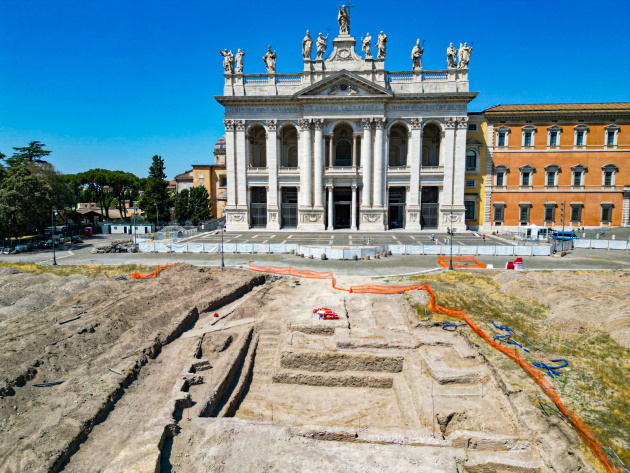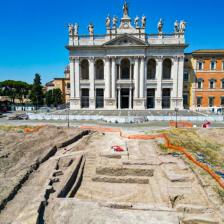
The archaeological investigations conducted by the Special Superintendency of Rome, directed by Daniela Porro, for the redevelopment of Piazza San Giovanni in Laterano in view of the forthcoming Jubilee, have brought to light some wall structures datable between the 9th and 13th centuries AD, possibly attributable to the Patriarchium.
Built at the behest of Constantine in the 4th century A.D. in place of the barracks of the Equites Singulares, the emperor's mounted guards who had sided with Maxentius, the Patriarchium initially consisted of a monumental basilica. It was enlarged several times during the Middle Ages and renovated to become the papal seat until the pontiff's official seat was moved to Avignon in 1305.
The findings, which are of extraordinary importance for Rome and its medieval history, consist of a construction that could have served either as a wall, made of large blocks of tufa, placed to defend the papal residence or as a substructure of the slope that characterised the Lateran area in ancient times.
The building of the structure took place when Rome was being raided by the Saracens and there was constant fighting, sometimes violent, between the aristocratic families claiming access to the throne of Peter, which reinforces the hypothesis that the wall had the function of a defensive wall around the Basilica complex and the adjoining palaces.
After the Avignonese Captivity, following the return of the popes to Rome and the transfer of the papal seat to the Vatican, the need for a structure to defend the Patriarchium disappears. As a result, the wall lost its functionality and was demolished and buried, and all memory of it was lost.
At the centre of the excavation, the following were also identified
- a portion of a reticulated wall, datable between the 1st century BC and 1st century AD, whose function was to terrace the slope that characterised the area;
- some imposing reticulated foundations that can be dated to the Severan period (3rd century AD);
- two opus latericium walls running parallel at 3.5 metres below the current floor level, probably part of an underground structure;
- a section of wall structure in opus listata, datable between the 4th and 7th centuries.
The set of discoveries that have come to light in Piazza San Giovanni gives a glimpse of the life and development of this area of Rome, up to the redevelopment ordered by Sixtus V in the 16th century.
For the time being, the findings will be left in situ and solutions will be studied for the future completion of the excavation and for their valorisation.
Foto: Ministero della Cultura
 Condividi
Condividi












































